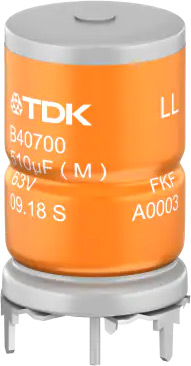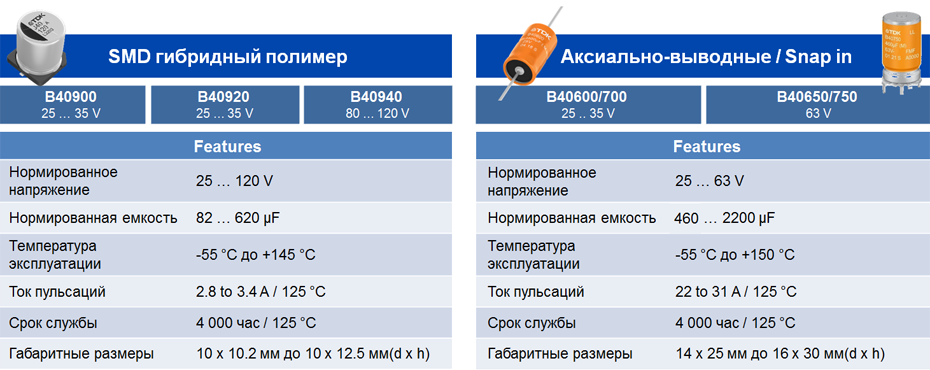Гибридные полимерно-алюминиевые электролитические конденсаторы типа SNAP-IN от TDK

В ассортименте гибридных полимерно-алюминиевых электролитических конденсаторов от компании TDK произошло расширение – появились новые гибридные электролитические конденсаторы типа snap-in серии B40700. Такие конденсаторы обладают выводами специальной формы – защелками, которые обеспечивают плотный контакт компонента с контактной площадкой в посадочных отверстиях, с дополнительными выводами для повышения надежности удержания компонента на печатной плате. По особенностям монтажа такие конденсаторы называют многовыводными (мультипиновыми) snap-in конденсаторами.
Гибридные полимерно-алюминиевые электролитические конденсаторы обладают двумя ключевыми преимуществами – у них очень низкое эквивалентное последовательное сопротивление (Equivalent Series Resistance – ESR) и, соответственно, очень высокое (в сравнении с обычными электролитическими конденсаторами) допустимое значение тока пульсаций.
Ключевые особенности и отличия гибридных полимерных конденсаторов

Эквивалентное последовательное сопротивление (ESR) удалось значительно уменьшить благодаря новой технологии комбинирования полимера с высокой проводимостью и жидкого электролита. Дополнительно эта технология даёт еще одно преимущество по сравнению с конденсаторами с использованием только полимера: гибридные полимерно-алюминиевые электролитические конденсаторы обладают свойствами самовосстановления – дефекты в оксидном слое диэлектрика подвергаются повторному оксидированию. Таким образом, у новых конденсаторов более высокая диэлектрическая прочность, термостойкость и долговечность по сравнению с традиционными полимерными алюминиевыми конденсаторами.
Наибольшее применение конденсаторов такого типа получили в автомобильных приложениях и в промышленности, например: двунаправленные преобразователи для сети 48В электротранспорта, инверторы для двигателей электромобилей или гибридных автомобилей, электрически управляемые системы рулевого управления, помпы, электрические турбозарядные устройства электромобилей, вентиляторы систем охлаждения, управление коробкой передач и выходные фильтры импульсных источников питания.
Сравнение snap-in гибридного полимерного конденсатора с конденсаторами других типов

Применение гибридных полимерно-алюминиевых электролитических конденсаторов позволяет экономить место на плате за счет их особенностей, заменяя несколько конденсаторов другого типа одним конденсатором типа SNAP-IN.
